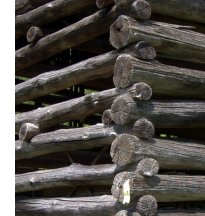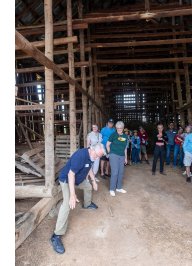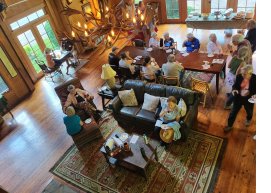The Interlocking Fingers of
Appalachian Log Barns
|
Many 21st century mountain farmsteads in Madison County often provide us with an inspiring collection of old (some would say, “antique”) log-crib barns from the 19th and early 20th centuries. The older farmsteads also included smaller log buildings, or “out-buildings”, used for a multitude of functions.
The “log crib” of the older livestock barns, is a kind of log box, commonly ten feet square and seven feet high, that serves as the stall for working draft animals or a milk cow. A few of these farmsteads have log houses that are older still, dating back to the late 18th century. It is both a challenge and a fascination to learn about these log buildings and how they have survived for more than a century.
Where did this building method come from? Looking at the oldest surviving log structures around the world, we find a Japanese log shrine built circa 600 CE/AD, and a Russian Orthodox church from 1655. These were both regions of the world that had cold winters, and vast expanses of forests from which to build sturdy log structures to survive the wind and cold.
As the new world of America was settled, European immigrants brought with them the traditional skills that had endured in their home countries: northern Europeans retained their log building traditions and those of the British Isles, their stone building techniques. The British Isles had by this time depleted their forests to build structures for Royalty, the Church, a large Navy, agriculture to feed an exploding population, and for fuelwood. The stone-building skills brought by these immigrants were abandoned over time, and they learned from eastern Europeans to use trees from the seemingly endless, virgin forests.
Scandinavians and Germans dominated in the building of fine log buildings, sharing these skills with other nationalities as they settled into several “hearth” communities, where the newly arrived learned the ways of the frontier. The closest hearth community to Madison County was the Watauga Settlement along the northern border of North Carolina and Tennessee, from which many of our early settlers arrived.
The cabin and barn traditions that emerged included traditional techniques for connecting the corners of log structures; the ends of the logs like interlaced fingers, or notched corners, locked into place. These included the half dovetail notch, the V-notch, and the saddle notch. Rarely one might find a simple half-lap notch, which had to be locked with wooden pegs. These log cribs were built by four men sitting at each corner, receiving the next log from the crew below, and lifting then into place, while trimming the notches with chisels and drawknives to assure the tightest fit. Below are examples of these notches and their use.
Half-Dovetail Notch
The half-dovetail notch represents the older notch tradition, used for earlier barns and other buildings in the community. It requires a larger log, hewn flat on the sides to remove the sapwood that was vulnerable to rot, and to provide a flat surface on the interior and exterior. The sloped cut angles drained any rainwater that might wet the notch, and locked the two logs together. Over time, the two log ends would settle into a perfectly tight position, both strong and aesthetically pleasing.
V- Notch
The V-notch, which actually forms an inverted “V” on the top, was also a preferred corner notch that, based on observed use, was used later in the settlement period. This notch did not lock itself in place, but required a peg or spike, and the weight of the upper structure. Log builders will debate which notch is better, or easier to craft.
Saddle Notch
 The name appropriately describes how the upper round log sits over the lower log, with the upper log having a curved “saddle” that locks it from moving in one direction. These notches were for smaller, round, not hewn logs, and were easier to craft and typically used for smaller buildings. They were also the preferred notch for the flu-cured tobacco barns introduced in 1870; many of that type still exist. The name appropriately describes how the upper round log sits over the lower log, with the upper log having a curved “saddle” that locks it from moving in one direction. These notches were for smaller, round, not hewn logs, and were easier to craft and typically used for smaller buildings. They were also the preferred notch for the flu-cured tobacco barns introduced in 1870; many of that type still exist.
Half-Lap Notch
The notch illustrated on this barn is known to have been built prior to 1843 by a prominent, early pioneer leader. Shown is a rare notch for a barn or house-- the half-lap notch. This notch required a peg or iron spike to lock it into place.
These various notches were the most common and could be found throughout the region. Occasionally one will find a barn log crib with notches that are rough and crudely made, not of a specific type. One wonders: was this a builder of less skill, or one that was rushed to complete a barn shelter before winter weather?
It is a testament to the endurance of this building technique with its ancient roots, and an honorably continued tradition into the mid-20th century.
|
|
Letter from our President
|
|
As we near the close of 2022, I would like to share the successes of these past few months. ABA received the news that we have received a grant from the Hart Family Fund for Small Towns (through the National Trust for Historic Preservation). This $6000 will be the “icing on the cake” when we have finished the approximate $30,000 restoration of the burley barn at the Smith Farm. This collection of audios and videos created will allow us to play “Barn Memories” as the visitors walk through the interior of that barn.
Using a tried-and-true formula for our Annual Barn Day, we hosted a successful event in a new area of the county. In November and December, we will introduce a new event with the help of a new friend—Miryam Rojas, owner of Mars Landing Galleries-- who will partner with an old group of friends—the Saints of Paint—to present an exhibit of the artists’ works. The Gallery and artists will share a portion of the sales' profits with both the ABA and SART.
I hope that you will take the time to read about these past few months’ successes and our upcoming exhibit in this newsletter. And, thank you for being an essential part of our success.
|
|
_______________________________________________________
The Old Barn “to be preserved, and to be used as an educational tool for people to know what we are all about around here, and where we came from. That’s what this barn is to me, a testament of where I came from. ” - Elaine Ray Thomas
_______________________________________________________
|
|
‘Barn Day’ success in
Hot Springs and Laurel
On a pleasant Sept. 3, enthusiastic ‘Barn Day’ supporters boarded three small vans at Bear River Lodge for a guided tour of three barns on the narrow passageways of Hot Springs and the Laurel community. It was our seventh such celebration and extremely welcome after two years of cancelations due to COVID and its variants.
Taylor Barnhill, longtime researcher for the Appalachian Barn Alliance, led the group. And, in addition to the narration along the way, he provided details about the barns on the stops. The first was the Willows Barn with a huge silo, part of the historic Dorland-Bell school campus in Hot Springs where boys farmed for room and board. In 1895, they managed to construct a route for a water pipe — two miles long — from the nearby mountain to water the crops! Another was built as a classic livestock barn on the large side — three stories high and 50 feet square, with timber frame construction and wooden-peg joinery. It’s to be converted into a residential center for children with cancer. The third was a terrific example of the architecture used for some of the first barns in Madison County to be built solely for air-curing burley tobacco. And, in addition to the narration along the way, he provided details about the barns on the stops. The first was the Willows Barn with a huge silo, part of the historic Dorland-Bell school campus in Hot Springs where boys farmed for room and board. In 1895, they managed to construct a route for a water pipe — two miles long — from the nearby mountain to water the crops! Another was built as a classic livestock barn on the large side — three stories high and 50 feet square, with timber frame construction and wooden-peg joinery. It’s to be converted into a residential center for children with cancer. The third was a terrific example of the architecture used for some of the first barns in Madison County to be built solely for air-curing burley tobacco.
When the vans returned to the lodge, the folks were treated to a barbecue dinner, complete with baked beans, coleslaw, deviled eggs, cheese-beer dip, a plentiful charcuterie platter, tofu barbecue, homemade banana pudding and a handsome cake with a delectable decoration of a barn on top, courtesy of Ingles.
 As patrons made their way to outdoor seating along the river, the legendary Roger Howell, who has 650 fiddle tunes on 25 CDs in the Southern Appalachian Archives at Mars Hill University, played his trusty instrument while, remarkably, never looking at a note. As patrons made their way to outdoor seating along the river, the legendary Roger Howell, who has 650 fiddle tunes on 25 CDs in the Southern Appalachian Archives at Mars Hill University, played his trusty instrument while, remarkably, never looking at a note.
Other activities awaiting participants included retail sales of items fashioned from old tobacco sticks, and a silent auction which offered a variety of items, a framed barn photo by longtime nature photographer Don McGowan, a stately vase by prominent potters Jim and Shirl Parmentier, notecards by Connie Kramer, a wine tasting by Metro Wines, a tour of Madison County’s natural history and music heritage by Taylor Barnhill, and certificates for meals from a host of restaurants, including Twisted Laurel, Soba Sushi, Eluvium Bakery, Chapala Mexican and Well-Bred Bakery of Weaverville, Moe’s Original Barbecue of Woodfin, and Maggie B’s.
When the event was said and done, the Alliance netted over $3,600, which will be used to help reconstruct the burley barn at the Smith Heritage Farmstead in Mars Hill. Thanks to all participants for investing in our heritage!
|
|
Mark your Calendars--Upcoming Events
|
- Saturday, October 8 from 10am to 4pm: Visit our booth at the Bascom Lamar Lunsford Festival on the Mars Hill University Quad. Quilt Raffle Drawing will take place at 3pm so you can buy your raffle tickets up until 2:55pm. Call 828 380-9146 to arrange to buy raffle tickets or go to our Quilt Raffle 2022 page.
- Friday, November 4 from 5pm to 8pm: Opening Night of "Saints of Paint-- Unearthed" Art Exhibit at Mars Landing Galleries in which a percentage of the proceeds of the art sales will benefit the ABA (and Southern Appalachian Repertory Theatre). This is part of the town's First Friday events and so, lots of exciting things are happening on Main Street, too. The Exhibit will continue until December 31 (and during that period all sales of the art in that show will benefit the ABA and SART). Mars Landing Galleries is located at 37 Library Street, Mars Hill 28754 (828-747-7627) and is open Wednesday through Saturday, 11-5 p.m. Watch for details.
- Friday, November 4 from 3:30pm to 6pm and All Day on Saturday, November 5 (beginning at 7:30am): Barn Photo Workshop conducted by Bonnie Cooper. Access to barn and farm property and tips for photographing the scenes. Cost is $150 ($125 for members) and space is limited to 8. You can make a reservations by phone 828 380-9146 or email info@appalachianbarns.org
- Wednesday, November 9 from 10am to 11am: Join us for our Annual Meeting. This year we will gather at the Mars Landing Gallery in order to highlight the "Saints of Paint -- Unearthed" exhibit there. Sales of any of the paintings will benefit the ABA. We will make a very short presentation about our successes in 2022 and our plans for 2023 at 10:30. But, the rest of the time, you can enjoy complimentary coffee and pastries and mingle with some of the artists and ABA Board members before the Gallery opens at 11am. No RSVP needed. Just drop in. We would love to see you!
|
|
ABA is awarded a prestigious National Trust for Historic Preservation grant
|
In 2022, the Hart Family Fund for Small Towns invited organizations to apply for grants that would encourage preservation at the local level by providing seed money for preservation projects in small towns. Well, isn't that what the ABA has been doing for the last ten years? Recently with our partnership with the town of Mars Hill in restoring the barns on the Smith Heritage Farmstead, we have been thinking of ways to encourage people to come inside those barns and learn more about farm life during the time when the barns were a central focus of the people's lives.

Our grant application described a project we are calling "Barn Memories" in which our researcher will record people throughout the county talking about just that. Then, we would extract 2 to 3 minutes which visitors to the barns on the Smith Farm could access and listen to or watch using their cell phone on a QR code on a sign. We were delighted to received notification that our request was chosen to receive $6000 from the Hart Family Fund for Small Towns.
We invite you to watch the progress as we use funding from our Pastoral Palette Art Gala sales and a grant from the Madison County TDA to restore the burley barn at the Smith Farm. When that project is completed, we will mount the signs with the QR codes to help visitors imagine what life was like when that barn or others like it was the center of their existence.
|
|
Just two more spots left in the Barn Photography Workshop November 4 and 5
|
The ABA friend and Asheville photographer Bonnie Cooper has partnered with the ABA  researcher Taylor Barnhill to allow a small group of interested photographers to get "up close and personal" with several of the historic barns in the county. researcher Taylor Barnhill to allow a small group of interested photographers to get "up close and personal" with several of the historic barns in the county.
Get tips on taking the best photograph while learning about the history of that barn from Taylor. Friday, November 4 from 3:30 to 6pm you will have a introduction and overview in preparation for going out in the county on Saturday, November 5 for the whole day (starting at 7:30am). Cost is $150 (or $125 if you are a 2022 member) and you can sign up by emailing info@appalachianbarns.org or calling 828 380-9146.
|
|
Last chance for our 2022 Quilt Raffle
|
The drawing to determine the winner of this year's quilt raffle will take place at the Bascom Lamar Lunsford Festival on October 8 at 3pm. This beautiful 46" x 47.5" quilt "Succulent Star" by Jennifer Woodruff was donated by a member of the ABA for our raffle. You can phone 828 380-9146 to arrange to buy the chances or stop by our booth at the Lunsford Festival on the MHU Quad before 3pm on October 8. Bascom Lamar Lunsford Festival on October 8 at 3pm. This beautiful 46" x 47.5" quilt "Succulent Star" by Jennifer Woodruff was donated by a member of the ABA for our raffle. You can phone 828 380-9146 to arrange to buy the chances or stop by our booth at the Lunsford Festival on the MHU Quad before 3pm on October 8.
|
|
Our favorite artists from Asheville – the Saints of Paint – will be back for our benefit, but this time in Mars Hill at the Mars Landing Galleries. Not only will the sale of their art benefit the ABA but they are extending their “gift” to include the Southern Appalachian Repertory Theatre (SART). Did you miss the opportunity to buy a painting at our Art Gala in June at Echoview Fiber Mill? Here’s your chance to see what else they have to offer. Some familiar names including Saints of Paint founder John MacKah (his painting of Grandfather Mountain is below) will have their work on exhibit at “The Saints of Paint – Unearthed” beginning with their opening night on First Friday, November 4 from 5pm to 8pm.
The exhibit and the benefit of a percentage of the sales going to the ABA & SART will continue through December 31. So, if you don’t get to the opening night, drop by Mars Landing Galleries at 37 Library Street in Mars Hill, Wednesday through Saturday from 11am to 5pm to see the exhibit.
Another chance to mingle with the artists will be at the Gallery when the ABA has their Annual Meeting (just a 10-minute talk) and welcomes you to stop by for coffee and pastries. The ABA Board members will be there to talk with you about our successes in 2022 and our plans for 2023. This will be on Wednesday, November 9 from 9am to 10am – the hour before the Gallery normally opens to the public.
|
|
 Please forward this to an interested friend. Please forward this to an interested friend. |
|
|
|
|
|
|